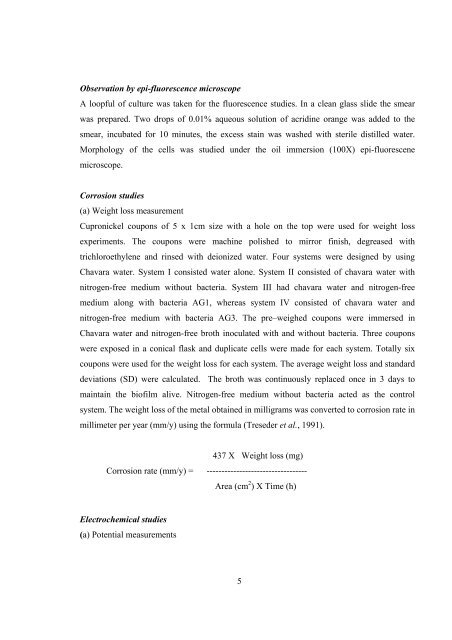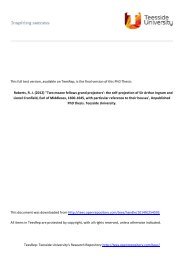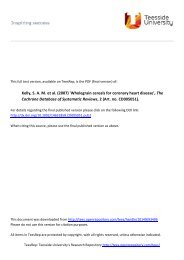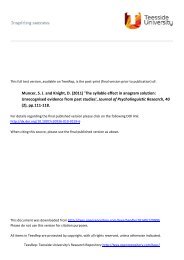Maruthamuthu, S. et al. - Teesside's Research Repository
Maruthamuthu, S. et al. - Teesside's Research Repository
Maruthamuthu, S. et al. - Teesside's Research Repository
Create successful ePaper yourself
Turn your PDF publications into a flip-book with our unique Google optimized e-Paper software.
Observation by epi-fluorescence microscope<br />
A loopful of culture was taken for the fluorescence studies. In a clean glass slide the smear<br />
was prepared. Two drops of 0.01% aqueous solution of acridine orange was added to the<br />
smear, incubated for 10 minutes, the excess stain was washed with sterile distilled water.<br />
Morphology of the cells was studied under the oil immersion (100X) epi-fluorescene<br />
microscope.<br />
Corrosion studies<br />
(a) Weight loss measurement<br />
Cupronickel coupons of 5 x 1cm size with a hole on the top were used for weight loss<br />
experiments. The coupons were machine polished to mirror finish, degreased with<br />
trichloro<strong>et</strong>hylene and rinsed with deionized water. Four systems were designed by using<br />
Chavara water. System I consisted water <strong>al</strong>one. System II consisted of chavara water with<br />
nitrogen-free medium without bacteria. System III had chavara water and nitrogen-free<br />
medium <strong>al</strong>ong with bacteria AG1, whereas system IV consisted of chavara water and<br />
nitrogen-free medium with bacteria AG3. The pre–weighed coupons were immersed in<br />
Chavara water and nitrogen-free broth inoculated with and without bacteria. Three coupons<br />
were exposed in a conic<strong>al</strong> flask and duplicate cells were made for each system. Tot<strong>al</strong>ly six<br />
coupons were used for the weight loss for each system. The average weight loss and standard<br />
deviations (SD) were c<strong>al</strong>culated. The broth was continuously replaced once in 3 days to<br />
maintain the biofilm <strong>al</strong>ive. Nitrogen-free medium without bacteria acted as the control<br />
system. The weight loss of the m<strong>et</strong><strong>al</strong> obtained in milligrams was converted to corrosion rate in<br />
millim<strong>et</strong>er per year (mm/y) using the formula (Treseder <strong>et</strong> <strong>al</strong>., 1991).<br />
437 X Weight loss (mg)<br />
Corrosion rate (mm/y) = ----------------------------------<br />
Area (cm 2 ) X Time (h)<br />
Electrochemic<strong>al</strong> studies<br />
(a) Potenti<strong>al</strong> measurements<br />
5





